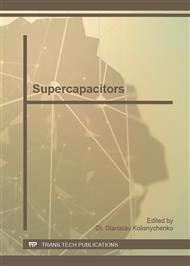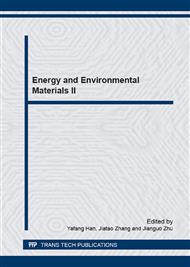[1]
Kötz R, Carlen M, Principles and applications of electrochemical capacitors, Electrochimica Acta. 45(2000) 2483-2498.
DOI: 10.1016/s0013-4686(00)00354-6
Google Scholar
[2]
JináFan H, Ultrathin nickel hydroxidenitrate nanoflakes branched on nanowire arrays for high-rate pseudocapacitive energy storage, Chemical Communications. 47(2011) 3436-3438.
DOI: 10.1039/c0cc04906a
Google Scholar
[3]
Wang H, Yoshio M. Graphite, a suitable positive electrode material for high-energy electrochemical capacitors, Electrochemistry communications. 8(2006) 1481-1486.
DOI: 10.1016/j.elecom.2006.07.016
Google Scholar
[4]
Conway B E, Transition from supercapacitor" to "battery, behavior in electrochemical energy storage, Journal of the Electrochemical Society. 138(1991) 1539-1548.
DOI: 10.1149/1.2085829
Google Scholar
[5]
Trasatti S, Kurzweil P, Electrochemical supercapacitors as versatile energy stores, Platinum Metals Rev. 38(1991) 46-56.
Google Scholar
[6]
Sarangapani S, Tilak B V, Chen C P, Materials for electrochemical capacitors theoretical and experimental constraints, Journal of the Electrochemical Society. 143(1996) 3791-3799.
DOI: 10.1149/1.1837291
Google Scholar
[7]
Pang S C, Anderson M A, Chapman T W, Novel electrode materials for thin-film ultracapacitors: comparison of electrochemical properties of sol-gel-derived and electrodeposited manganese dioxide, Journal of the Electrochemical Society. 147(2000).
DOI: 10.1149/1.1393216
Google Scholar
[8]
Wang G, Shao Z, Yu Z, Comparisons of different carbon conductive additives on the electrochemical performance of activated carbon, Nanotechnology. 18(2007) 205705.
DOI: 10.1088/0957-4484/18/20/205705
Google Scholar
[9]
Wang D, Ni W, Pang H, et al, Preparation of mesoporous NiO with a bimodal pore size distribution and application in electrochemical capacitors, Electrochimica Acta. 55(2010): 6830-6835.
DOI: 10.1016/j.electacta.2010.05.084
Google Scholar
[10]
Zhao D D, Xu M W, Zhou W J, et al, Preparation of ordered mesoporous nickel oxide film electrodes via lyotropic liquid crystal templated electrodeposition route, Electrochimica Acta. 53(2008) 2699-2705.
DOI: 10.1016/j.electacta.2007.07.053
Google Scholar
[11]
Yu C, Zhang L, Shi J, et al, A Simple Template-Free Strategy to Synthesize Nanoporous Manganese and Nickel Oxides with Narrow Pore Size Distribution, and Their Electrochemical Properties, Advanced Functional Materials. 18(2008) 1544-1554.
DOI: 10.1002/adfm.200701052
Google Scholar
[12]
Wang Y, Xia Y, Electrochemical capacitance characterization of NiO with ordered mesoporous structure synthesized by template SBA-15, Electrochimica Acta. 51(2006) 3223-3227.
DOI: 10.1016/j.electacta.2005.09.013
Google Scholar
[13]
Justin P, Meher S K, Rao G R, Tuning of capacitance behavior of NiO using anionic, cationic, and nonionic surfactants by hydrothermal synthesis, The Journal of Physical Chemistry C. 114(2010) 5203-5210.
DOI: 10.1021/jp9097155
Google Scholar
[14]
Yuan C, Zhang X, Su L, et al, Facile synthesis and self-assembly of hierarchical porous NiO nano/micro spherical superstructures for high performance supercapacitors, Journal of Materials Chemistry. 19(2009) 5772-5777.
DOI: 10.1039/b902221j
Google Scholar
[15]
Kim H K, Seong T Y, Lim J H, et al, Electrochemical and structural properties of radio frequency sputtered cobalt oxide electrodes for thin-film supercapacitors, Journal of power sources. 102(2001) 167-171.
DOI: 10.1016/s0378-7753(01)00864-3
Google Scholar
[16]
Du X, Wang C, Chen M, et al, Electrochemical performances of nanoparticle Fe3O4/activated carbon supercapacitor using KOH electrolyte solution, The Journal of Physical Chemistry C. 113(2009) 2643-2646.
DOI: 10.1021/jp8088269
Google Scholar
[17]
Wang G, Shen X, Horvat J, et al, Hydrothermal synthesis and optical, magnetic, and supercapacitance properties of nanoporous cobalt oxide nanorods, The Journal of Physical Chemistry C. 113(2009) 4357-4361.
DOI: 10.1021/jp8106149
Google Scholar
[18]
Reddy R N, Reddy R G, Sol-gel MnO2 as an electrode material for electrochemical capacitors, Journal of Power Sources. 124(2003) 330-337.
DOI: 10.1016/s0378-7753(03)00600-1
Google Scholar



